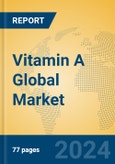The Vitamin A market is crucial within the broader dietary supplement and nutritional sectors, playing a fundamental role in human health, nutrition, and various industries such as cosmetics and food production. Vitamin A is essential for vision, immune function, and skin health, among other physiological processes. This review explores the market dynamics, size, key trends, and forecasts for the period from 2024 to 2029.
Companies are also actively engaging in sustainability initiatives. Many players are focusing on reducing their carbon footprint and sourcing Vitamin A ingredients sustainably to appeal to environmentally conscious consumers.
This product will be delivered within 1-3 business days.
Market Size
The global Vitamin A market was valued at approximately USD 1.73 billion in 2023 and is anticipated to grow at a Compound Annual Growth Rate (CAGR) of around 3.5% from 2024 to 2029, reaching an estimated USD 2.09 billion by 2029. This growth is driven by increasing health consciousness among consumers, rising demand in the dietary supplement sector, and the expanding use of Vitamin A in the food and cosmetics industries.Share & Trends Analysis
By Product Type
Vitamin A products can be segmented into two primary types: natural and synthetic. The natural Vitamin A segment is projected to dominate the market, accounting for over 65% share in 2023. This trend is fueled by a growing preference for natural ingredients in dietary supplements and cosmetics, with consumers becoming more aware of their health choices.By Key Players
The Vitamin A market is characterized by the presence of several key players, including:- DSM Nutritional Products
- BASF SE
- Syngenta AG
- FMC Corporation
- Nutricia
By Process
- The Vitamin A production process can be divided into several categories: synthesis, extraction, and fermentation.
- Synthesis: This is the most common method of Vitamin A production, contributing to around 70% of the market share.
- Extraction: Gaining popularity in the natural products sector, this method accounts for approximately 20% of the market.
- Fermentation: A less common but emerging method, accounting for around 10% of production.
By Application
Vitamin A finds application in various sectors:- Dietary Supplements: This segment holds the largest share, driven by rising health consciousness among consumers.
- Food & Beverages: Increasing incorporation in food fortification is resulting in significant market growth.
- Cosmetics: Applied in skin care products, it has seen steady growth due to demand for natural ingredients.
By End-Use
The end-use sectors for Vitamin A include:- Pharmaceuticals: Utilized in the production of Vitamin A-based medicines.
- Food & Beverage: Increasingly used for food fortification, particularly in products targeting children.
- Cosmetics & Personal Care: Used in formulations targeting skin health and anti-aging.
By Region
- The Vitamin A market exhibits geographical variations.
- North America: The leading market, accounting for approximately 30% share, with a robust dietary supplement industry.
- Europe: Holding a significant share due to stringent regulations promoting the use of fortified food products.
- Asia-Pacific: Emerging as a fast-growing region due to increasing health awareness and rising disposable incomes.
- Latin America and Middle East & Africa: Expected to witness moderate growth fueled by expanding health sectors.
Market News and Policy Updates
Recent government initiatives have focused on enhancing nutrition standards. For instance, the EU's Food Fortification policies have encouraged the incorporation of Vitamin A into products aimed at tackling nutrient deficiencies, potentially expanding its market size.Companies are also actively engaging in sustainability initiatives. Many players are focusing on reducing their carbon footprint and sourcing Vitamin A ingredients sustainably to appeal to environmentally conscious consumers.
Segment Forecasts (2024-2029)
The following segments are anticipated to show promising growth based on current trends:- Organic Vitamin A Supplements: Expected to grow at a CAGR of over 5% as demand for organic products rises.
- Food Fortification: Estimated to surpass USD 1 billion by 2029, driven by government policies promoting improved nutrition.
- Cosmetics Industry Usage: Anticipated to grow significantly as demand for natural ingredients in beauty products increases.
Conclusion
The Vitamin A market is on a trajectory of robust growth driven by health trends, regulatory support for food fortification, and an increasing demand for natural products across various industries. As we move toward 2029, stakeholders must stay attuned to evolving consumer preferences and regulatory developments to capitalize on growth opportunities within this essential nutrient segment.This product will be delivered within 1-3 business days.
Table of Contents
Chapter 1 Executive SummaryChapter 2 Abbreviation and Acronyms
Chapter 3 Preface
Chapter 4 Market Landscape
Chapter 5 Market Trend Analysis
Chapter 6 Industry Chain Analysis
Chapter 7 Latest Market Dynamics
Chapter 8 Trading Analysis
Chapter 9 Historical and Forecast Vitamin A Market in North America (2019-2029)
Chapter 10 Historical and Forecast Vitamin A Market in South America (2019-2029)
Chapter 11 Historical and Forecast Vitamin A Market in Asia & Pacific (2019-2029)
Chapter 12 Historical and Forecast Vitamin A Market in Europe (2019-2029)
Chapter 13 Historical and Forecast Vitamin A Market in MEA (2019-2029)
Chapter 14 Summary For Global Vitamin A Market (2019-2024)
Chapter 15 Global Vitamin A Market Forecast (2024-2029)
Chapter 16 Analysis of Global Key Vendors
List of Tables and Figures
Companies Mentioned
- BASF
- NHU
- DSM
- Adisseo
- Kingdomway
- ZMC








